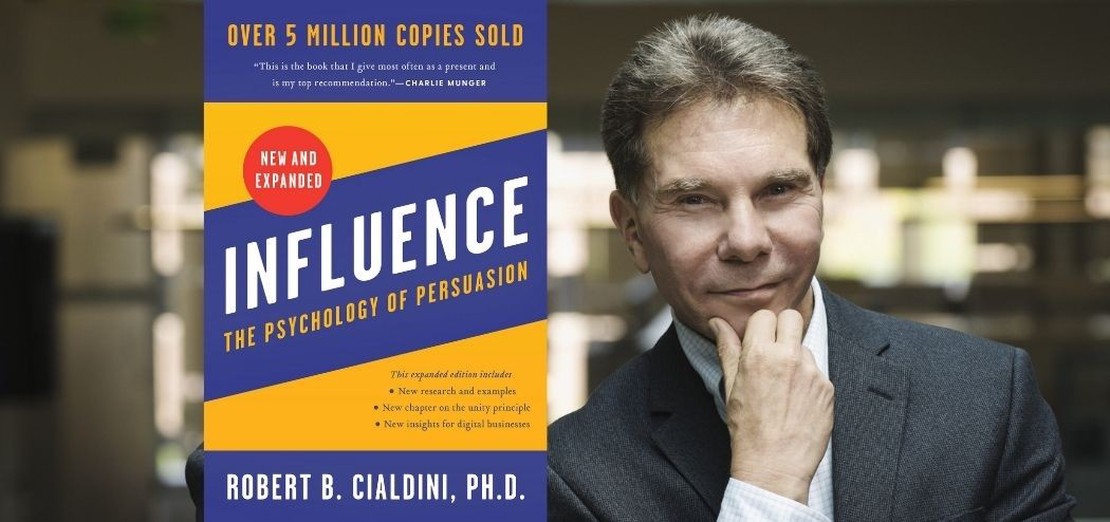
Influence: The Psychology of Persuasion
- Harun Bekri
- Books
- December 3, 2023
Have you ever wondered why we often find ourselves saying “yes” to requests from others, even when we may not fully understand why? It turns out that our automatic response to certain triggers plays a significant role in our decision-making processes. Dr. Robert Cialdini is a distinguished social psychologist and professor emeritus of Psychology and Marketing at Arizona State University. Drawing from decades of research and experiments, Dr. Cialdini identified seven key principles of persuasion that shape our compliance with requests and examines the psychological mechanisms that drive our automatic responses.
In this blog article, we will explore each of these principles in-depth, examining the research studies that support their validity and demonstrating why humans have automatic action triggers in response to certain stimuli. By understanding the psychological underpinnings of persuasion, we can navigate the complexities of influence with greater awareness and effectiveness just like A jujitsu martial artist may use leverage to turn an opponent’s strength against them. By using their own body weight and positioning. The ability to manipulate without the appearance of manipulation is a super power. Even the victims themselves tend to see their compliance as a result of the action of natural forces rather than the designs of the person who profits from that compliance.
Reciprocation: Give and Take
Reciprocation is a fundamental principle of human behavior. When someone does something for us, we feel a strong urge to repay the favor. Cialdini emphasizes that this principle is not limited to material goods but extends to acts of kindness and concessions. The rule of reciprocation has been deeply implanted in us by the process of socialization we all undergo, and continues to shape human interactions and relationships to this day. By initiating a positive action, favor or gift without being requested, we can create a sense of indebtedness, increasing the likelihood of receiving a favorable response in return. Because there is a general distaste for those who take and make no effort to give in return, people will often go to great lengths to avoid being considered a freeloader.
when we offer favors it’s important to avoid minimizing the favor in a way that disengages the influence of the rule of reciprocation. Common phrases like “No big deal” or “Don’t think a thing about it” can diminish the impact of the favor and weaken the sense of obligation that the recipient may feel to repay it in the future. instead we should be retaining the influence of the rule of reciprocation by acknowledging the favor and saying something like " if our positions were ever reversed, I know you’d do the same for me."
Study - In one Southern California candy shop, researchers examined the buying patterns of customers who either did or did not receive a free piece of candy as they entered. Receiving the gift made recipients 42 percent more likely to make a purchase. Of course, it’s possible their increased buying wasn’t caused by the pull of reciprocity. Perhaps these customers simply liked what they’d tasted so much, they bought more of it. But a closer look doesn’t support this explanation. The recipients didn’t buy more of the candy they’d sampled; they only bought more of other types of candy. Seemingly, even if they didn’t particularly like the candy they were given, they still felt obligated to return the favor by purchasing something.
We have already seen that one consequence of the rule of reciprocity is an obligation to repay favors. Another consequence, however, is an obligation to make a concession to someone who has made a concession to us. The idea of a “concession” refers to a change in the original request that is made in order to make it more appealing or easier for the other person to fulfill. for example if If I want you to lend me $10, I can make the request seem smaller than it is by first asking you to lend me $20. One of the beauties of this tactic is that by first requesting $20 and then retreating to $10, I will have simultaneously engaged the force of both the reciprocity rule and the contrast principle. Not only will my $10 request be viewed as a concession to be reciprocated, but it will look like a smaller request than if I had just asked for $10 straightaway. The additional advantage of the technique is not really a psychological principle, as in the case of the other two factors. Rather, it is more of a purely structural feature of the request sequence. Let’s once again say that I wish to borrow $10 from you. By beginning with a request for $20, I really can’t lose. If you agree to it, I will have received from you twice the amount I would have settled for. If, on the other hand, you turn down my initial request, I can retreat to the $10 favor that I desired from the outset and, through the action of the reciprocity and contrast principles, greatly enhance my likelihood of success. Either way, I benefit; it’s a case of heads I win, tails you lose.
Liking
People prefer to say yes to individuals they know, like, and trust. By Recognizing this rule, sales people commonly increase their effectiveness by mentionig a friend’s name of the potential buyer. they say things like “your neighbour liked the product and told me to show it to you” Turning the salesperson away under these circumstances is difficult; it’s almost like rejecting your neighbour. Although it has long been suspected that physical beauty provides an advantage in social interaction, research indicates the advantage may be greater than supposed. Physical attractiveness engenders a halo effect that leads to the assignment of other traits such as talent, kindness, and intelligence. As a result, attractive people are more persuasive both in terms of getting what they request and changing others’ attitudes.
A second factor that influences liking and compliance is similarity. We like people who are like us, and we are more willing to say yes to their requests, often in an unthinking manner. Another such factor is praise. Compliments generally enhance liking and, hence, compliance. Increased familiarity through repeated contact with a person or thing is yet another factor that normally facilitates liking. This relationship holds true principally when the contact takes place under positive rather than negative circumstances. One positive circumstance that works especially well is mutual and successful cooperation. A fifth factor linked to liking is association. By connecting themselves or their products with positive things or celebrities, advertisers, politicians, and merchandisers frequently seek to share in the positivity through the process of association. The principle of association is a general one, governing both negative and positive connections. An innocent association with either bad things or good things will influence how people feel about us. brands like Nike make deals with athletes to associate their shoe with the athlete’s known qualities and talents.
Social Proof
Social proof suggests that when we are uncertain, we tend two look to others’ actions and behaviors to guide our own decisions. The tendency to see an action as appropriate when others are doing it works quite well normally. As a rule, we make fewer mistakes by acting in accord with social evidence than by acting contrary to it. Usually, when a lot of people are doing something, it is probably the right thing to do.This feature of the principle of social proof is simultaneously its major strength and major weakness. Like the other levers of influence, it provides a convenient shortcut for determining the way to behave, but at the same time, it makes one who uses the shortcut vulnerable to the attacks of profiteers who lie in wait along its path. Examples are plentiful. Certain nightclub owners manufacture a brand of visible social proof for their clubs’ quality by creating long waiting lines outside when there is plenty of room inside.
One way uncertainty develops is through lack of familiarity with the situation. Under such circumstances, people are especially likely to follow the lead of others. Consider how this simple insight made one man a multimillionaire. His name was Sylvan Goldman and, after acquiring several small grocery stores in 1934, he noticed his customers stopped buying when their handheld shopping baskets got too heavy. This inspired him to invent the shopping cart, The contraption was so unfamiliar-looking that, at first, none of Goldman’s customers used one—even after he built a more than- adequate supply, placed several in a prominent place in the store, and erected signs describing their uses and benefits. Frustrated and about to give up, he tried one more idea to reduce his customers’ uncertainty, one based on social proof. He hired shoppers to wheel the carts through the store. His true customers soon began following suit, his invention swept the nation, and he died a wealthy man with an estate of over $400 million.
We can see how, at different times and in different cultures, it has been possible to profit from manufactured social proof. In today’s TV sitcoms, we no longer have claqueurs and rieurs to fool us into laughing longer and harder. Instead, we have “laughtrackers” and “sweeteners”—audio technicians whose job is to enhance the laughter of studio audiences to make the programs’ comic material seem funnier to their true targets: TV viewers such as you and me. Sad to say, we are likely to fall for their tricks. Experiments show that the use of fabricated merriment leads audiences to laugh more frequently and longer. fake reviews and product testimonials are also social proof weapons used by ecommerce sites and online stores. If one person says you have a tail, you laugh it off as stupid; but, if three people say it, you turn around. The principle of social proof operates most powerfully when we are observing the behavior of people just like us. Advertisers know that one successful way to sell a product to ordinary viewers (who compose the largest potential market) is to demonstrate that other “ordinary” people like and use it. Whether the product is a brand of soft drink or a pain reliever.
Authority
From birth, we are taught to believe that obedience to proper authority is right and disobedience is wrong. This message is reinforced in our childhood through parental lessons, schoolhouse rhymes, stories, and songs, and is carried forward into the legal, military, and political systems we encounter as adults. Concepts such as submission and loyalty to legitimate rule are highly valued in each system. religious instruction also contributes to the value placed on obedience to authority. From the start, these people (parents, teachers) knew more than we did, and we found taking their advice beneficial—partly because of their greater wisdom and partly because they controlled our rewards and punishments. As adults, the same benefits persist for the same reasons, though the authority figures are now employers, judges, and government leaders. once we realize that obedience to authority is mostly rewarding, it is easy to allow ourselves the convenience of automatic obedience. The simultaneous blessing and curse of such blind obedience is its mechanical character. We don’t have to think, therefore we don’t. Although such mindless obedience leads us to appropriate action most of the time, there will be conspicuous exceptions because we are reacting, not thinking. we can take an example from medicine to illustrate the potential dangers of blind obedience to authority. Physicians hold a position of great knowledge and influence, and the medical establishment has a clear hierarchy in which doctors sit at the top. A long-established tradition of automatic obedience to doctors’ orders has developed among healthcare staff, which can be problematic if a physician makes an error and no one lower in the hierarchy questions it. Patients, nurses, pharmacists, and other physicians often do not question the prescription, even if there is an error.
Whenever our behaviors are governed in such an unthinking manner, we can be confident there will be compliance professionals trying to take advantage. This profiteers might use titles, clothes and Accessories to resumble a professional in order to make us buy or do something. Advertizers in the pharmaceutical industry hire actors to look like doctors and promote the product. authority symbols can be easily faked which makes it so effective to impelement.
Scarcity : FOMO
The general idea of “loss aversion” is that people are more driven by the prospect of losing an item of value than by the prospect of gaining it—is the centerpiece of Nobel laureate Daniel Kahneman’s prospect theory, which has been generally supported by studies done in multiple countries and in multiple domains such as business, the military, and professional sports. In the world of business, for example, research has found that managers weigh potential losses more heavily than potential gains in their decisions. Individuals tend to feel the pain of losses more intensely than the pleasure of equivalent gains. It is worth asking what it is about the idea of loss that makes it so potent in human functioning. One prominent theory accounts for the primacy of loss over gain in evolutionary terms. If one has enough to survive, an increase in resources will be helpful but a decrease in those same resources could be fatal. In the medical field, messages that emphasize potential losses are found to be more effective in encouraging individuals to undergo tests for detecting illnesses, such as mammography procedures or cancer self-examinations.
With the scarcity principle operating so powerfully on the worth we assign things, it is natural that compliance professionals will do some similar operating of their own. Probably the most straightforward use of the scarcity principle occurs in the “limited number” tactic in which a customer is informed a certain product is in short supply that cannot be guaranteed to last long. This strategy creates a psycological discomfort in the consumers mind in that if they want the product later, they know they might not get it. another way the scarcity principle can be employed is using the “deadline” tactic, in which some official time limit or countdown is placed on the customer’s opportunity to get what’s being offered. As a result, people frequently find themselves acquiring what they don’t much favor simply because the time to do so is dwindling. Customers are often told that unless they make an immediate decision to buy, they will have to purchase the item at a higher price later or they won’t be able to purchase it at all.
Almost invariably, our response to banned information is to want to receive the information and to become more favorable toward it than we were before the ban. The intriguing finding within the effects of censored information on an audience is not that audience members want to have the information more than before; that seems natural. Rather, it is that they come to believe in the information more, even though they haven’t received. According to the principle, we will find a piece of information more persuasive and interesting if we think that we can’t get it elsewhere.
The feeling of being in competition for scarce resources has powerful motivating properties. and sales people know this very well when they encounter indecisive customers. For example, a real-estate agent who is trying to sell a house to a fence-sitting prospect sometimes calls the prospect with news of another potential buyer who has seen the house, liked it, and is scheduled to return the following day to discuss terms. When wholly fabricated, the new bidder is commonly described as an outsider with plenty of money: Favorites are “an out-of-state investor buying for tax purposes” and “a physician and his wife moving into town.” The tactic, called in some circles “goosing ’em off the fence,” can work devastatingly well. The thought of losing out to a rival frequently turns a buyer from hesitant to zealous. An auction works the same way by manufacturing a competition to increase the scarcity and desirability of the product to sell it more than it’s actually worth.
Consistency
consistency is our desire to be (and to appear) consistent with what we have already said or done. Once we make a choice or take a stand, we encounter personal and interpersonal pressures to think and behave consistently with that commitment. Moreover, those pressures will cause us to respond in ways that justify our decision. When researchers conducted theft simulations on a New York City beach, they observed how bystanders reacted to the crime. An accomplice of the researchers would place their beach blanket near a randomly selected individual. After some time, the accomplice would leave the blanket and walk down the beach. Then, a researcher pretending to be a thief would approach and try to steal a portable radio. Initially, only four out of twenty subjects intervened to stop the theft. However, when the accomplice simply asked the subjects to “watch my things” before leaving the blanket, nineteen out of twenty subjects became proactive, chasing and confronting the thief to protect the belongings. To understand why consistency is so powerful a motive, we should recognize that in most circumstances, it is valued and adaptive. Inconsistency is commonly thought to be an undesirable personality trait. The person whose beliefs, words, and deeds don’t match is seen as confused, two-faced, even mentally ill. On the other side, a high degree of consistency is normally associated with personal and intellectual strength.
Once a stand is taken, there is a natural tendency to behave in ways that are stubbornly aligned with the stand. Commitment strategies are commonly employed by compliance professionals to encourage individuals to take specific actions or make statements that would later bind them to comply with certain expectations or demands. Take for example this scenario of a job interview when A young man emplied the consistency principle on his own behalf. After assuring evaluators he wanted to answer all their questions as fully as possible, he added, “But, before we start, I wonder if you could answer a question for me. I’m curious, what was it about my background that attracted you to my candidacy?” As a consequence, his evaluators heard themselves saying positive things about him and his qualifications, committing themselves to reasons to hire him before he had to make the case himself. He swears he has gotten three better jobs in a row by employing this technique. By getting the interviewers to say good things about him he has created A psychological pressure on them to act consistently with their statement.
Unity
Automatically and incessantly, everyone divides people into those to whom the pronoun we does and does not apply. Those within the boundaries of “we” get more agreement, trust, help, liking, cooperation, emotional support, and forgiveness. People are inclined to say yes to someone they consider one of them. It’s about identities, shared identities. It’s about tribe-like categories that individuals use to define themselves and their groups, such as race, ethnicity, nationality, and family. Easily the greatest investment swindle of our time was the Ponzi scheme orchestrated by Wall Street insider Bernard Madoff. Madoff was Jewish, and so, too, were the majority of his victims, who were often recruited by Madoff’s lieutenants, who were also Jewish. In addition, new recruits knew and were ethnically similar to past recruits, who served as similar sources of social proof that an investment with Madoff must be a wise choice. Charles Ponzi, who gave his name to the infamous Ponzi scheme that Madoff ran, was an Italian immigrant to the United States who fleeced other Italian immigrants to the United States. He scammed millions of dollars from 1919 to 1920. A study of a large Indian bank’s records revealed loan officers approved more loan applications and gave more favorable terms to applicants of the same religion. Moreover, the favoritism may have worked both ways: a loan that incorporated a religious match resulted in significantly increased loan repayments.
Collective rituals and activities, such as songs, marches, rituals, chants, prayers, and dances, have been integral to human societies throughout history. These practices serve to bring people together and create a sense of unity and solidarity within a group. They have been observed in various forms across different cultures and time periods. From a behavioral science perspective, the reasons behind the development and persistence of these group-bonding practices are clear. When people engage in synchronized actions and coordinated responses, they experience a sense of being part of a unified entity. This feeling of group solidarity fosters loyalty and self-sacrifice, which are typically associated with smaller family units. In one set of studies, participants who read a story aloud together with a partner in unison (or in coordination by taking turns reading sentences of the story) came to feel greater “we”-ness and solidarity with their partner than did participants who read the story independently from their partner. A last demonstration of the phenomenon comes from a study of brain activity. When intensely involved in joint projects, participants’ brain-wave patterns began to match one another’s, rising and falling together.
Isn’t there some generally applicable mechanism that social entities could deploy to bring about such coordination to influence members toward group goals? There is. It’s music. And fortunately for individual communicators, it can be employed to move others toward the goals of a single agent of influence. Because of a unique collection of detectible regularities (rhythm, meter, intensity, pulse, and time), music possesses rare coordinating power. Listeners can easily become aligned with one another along motoric, vocal, and emotional dimensions.


